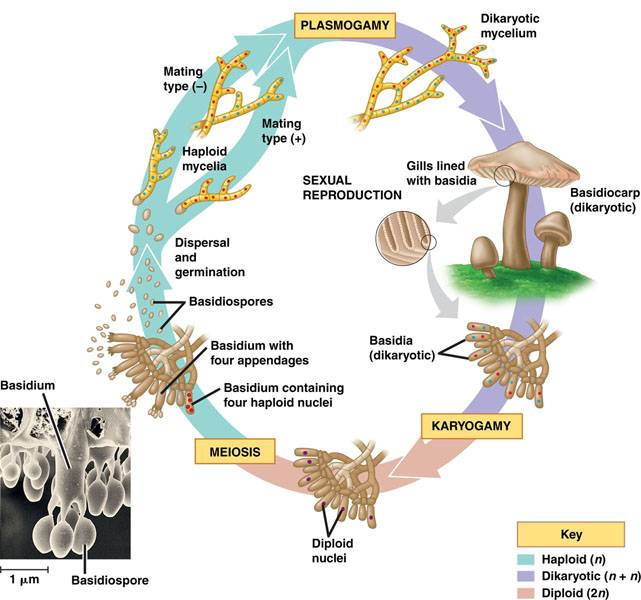
Reproduction
All basidiomycetes-Omphalotus nidiformis included-reproduce through sexual reproduction by producing basidiocarps. A basidiocarp is an elaborate fruiting body of a dikayotic mycelium of a club fungus. (Campbell and Reece et. al 2009) In reference to the picture, step one of the fungi's reproduction is the fusion of two haploid mycelia. Mycelium (plural, mycelia) is the hyphae of fungi being extended or lengthened. Hyphae is a thread-like filament structure composing of the mycelium formed by fungi. (Merriam-Webster 2012) The fusion of the cytoplasm of cells from two individuals is defined as plasmogamy which marks the beginning of the Dikaryotic period. Step two in this reproductive lifecycle is the growth of the dikaryon mycelium which ultimately crowds out the haploid parental mycelia. Step three involves environmental cues (change in temperature or rain) are responsible to induce the dikaryotic mycelium to form compact masses. These compact masses develop into mushrooms (basidiocarps). The mushroom gills lined with terminal dikaryotic cells-which increase the surface area of the cell-are called basidia (singular, basidium). This ends the dikaryotic duration of the cycle. The cycle transitions from dikaryotic to diploid through karyogamy which can be defined as the fusion of two nuclei. (Campbell and Reece et. al 2009) During this stage, in step five, a diploid nucleus is produced by each mushroom which then undergoes meiosis marking the end of the diploid period. Referencing step six, the cycle returns back to haploid when each diploid nucleus yields four haploid nuclei-growing four appendages. Each haploid nuclei produces a basidiospore. Basidiospores are the numerous basidia in a mushroom, the source of sexual spores and may be released by the billion which happens to be step seven. Basidiospores are ejected after the point which they reach maturity and are dispersed by the wind. Step eight and the final step of a basidiomycota life cycle is after the mature basidiospore has found a suitable environment to germinate and grow into short-lived haploid mycelium. (Campbell and Reece et. al 2009)

If you would like to continue learning about Omphalotus nidiformis, please continue on to Interactions page.